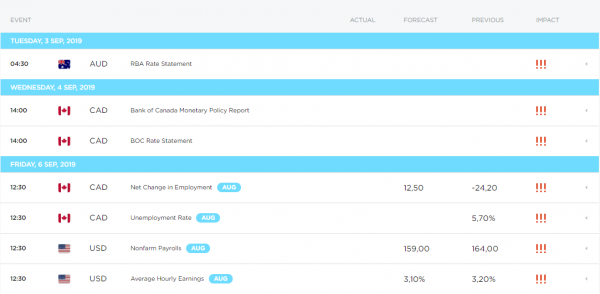The month of September starts with high-impacting macroeconomic data releases and central bank rate decisions. This week we see PMI manufacturing data releases from the Japanese, Chinese, UK, eurozone and United States economy economies and interest rate decisions from the Reserve Bank of Australia and the Bank of Canada. The RBA is widely expected to keep rates on hold after recent rate reductions, while the Bank of Canada is expected to remain neutral as growth expectations remain well-anchored.
The American economy also releases the important ISM Manufacturing report and the Nonfarm payroll job this week, with most economists expecting that the United States economy created 155,000 new jobs last month. We also see a host of US data and quarterly GDP numbers from the eurozone and Australian economies.
Monday 2nd September, EU Manufacturing PMI
The EU Manufacturing PMI reports on Manufacturing activity inside the eurozone economy and represents economic indicators derived from monthly surveys from key European companies. PMI data provides advance insight into the entire eurozone economy such as output, new orders, employment and prices across these key sectors.
- The EURUSD pair is bearish while trading below the 1.1100 level, key support is found at the 1.0900 and 1.0840 levels.
- If the EURUSD pair moves above the 1.1100 level, buyers are likely test towards the 1.1130 and 1.1200 resistance levels.
Tuesday 3rd September, AUD, RBA Rate Decision
The Reserve Bank of Australia Rate Decision is the market interest rate on overnight funds, with the RBA standing as the central monetary authority for the Australian economy. The Reserve Bank of Australia is widely expected to keep interest rates on hold at this meeting, following recent rate cuts. RBA policymakers are also tipped to strike an overall dovish tone towards the economy and monetary policy.
- The AUDUSD pair is bearish while trading below the 0.6850 level, key support is found at the 0.6650 and 0.6550 levels.
- If the AUDUSD pair moves above the 0.6850 level, buyers may test towards the 0.6910 and 0.6940 levels.
Wednesday 4th September, GBP UK Services PMI
The United Kingdom Services PMI is released by both the Chartered Institute of Purchasing and Supply and also Markit Economics. The UK Services PMI is a key indicator of the economic situation in the UK services sector which captures an overview of the condition of sales and employment. It is worth noting that the United Kingdom service sector comprises roughly eighty percent of the United Kingdom’s gross domestic product.
- The GBPUSD pair is bearish while trading below the 1.2195 level, key support is found at the 1.2100 and 1.1980 levels.
- If the GBPUSD pair trades above the 1.2200 level, buyers are likely to test towards the 1.2310 and 1.2380 resistance levels.
Thursday 5th September, USD US Private Sector Jobs
The ADP Private Sector employment change jobs report is released by the US Automatic Data Processing Inc and measures the change in the number of people employed inside the American private sector. A rise of this figure is seen as positive and good for stimulating US economic growth, while a weaker-than-expected number is seen as bearish and a possible indicator for future economic weakness.
- The USDCHF pair is only bearish while trading below the 0.9780 level, further downside towards the 0.9710 and 0.9640 support levels seems possible.
- If the USDCHF pair moves above the 0.9780 level, buyers are likely test towards the 0.9890 and 0.9950 resistance levels.
Friday 6th September, US Nonfarm Payrolls Job Report
The NFP job report shows the monthly change in employment in the American economy, excluding the farming sector. The Non-farm payrolls job report is the most carefully observed indicator in the employment situation inside the United States. It is considered the most inclusive calculation of job creation, which causes the Nonfarm Payrolls Job report to become highly significant to market participants, due to the great importance of labour in the United States economy.
- The USDJPY pair is bearish while trading below the 107.00 level, further losses towards the 105.80 and 104.50 levels remains possible.
- If the USDJPY pair trades above the 107.00 level, buyers are likely to test the 107.40 and 108.10 resistance levels.












